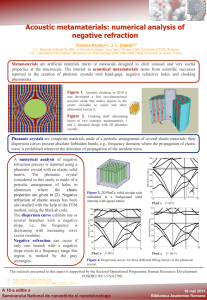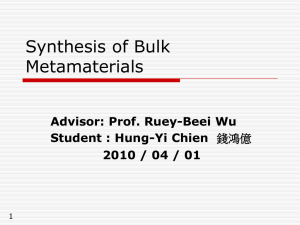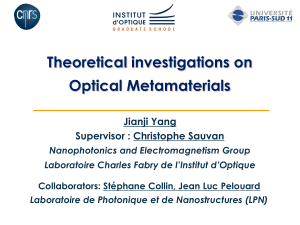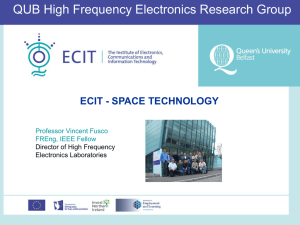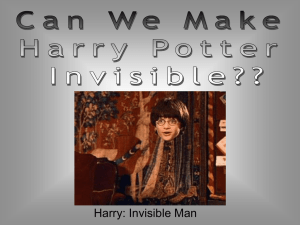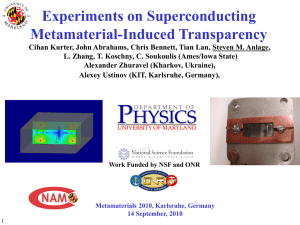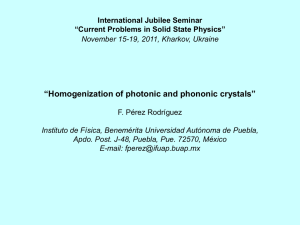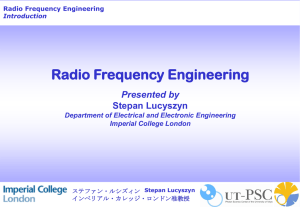Repulsive Casimir force in chiral metamaterials
advertisement
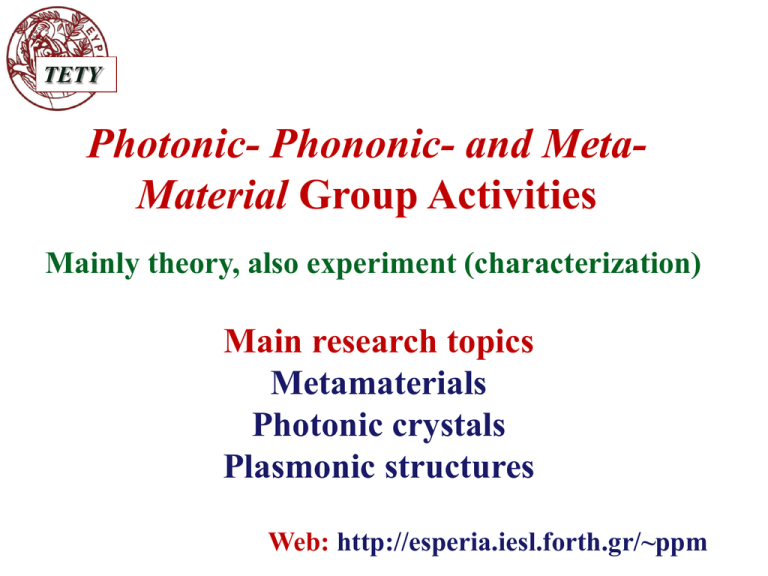
TETY Photonic- Phononic- and MetaMaterial Group Activities Mainly theory, also experiment (characterization) Main research topics Metamaterials Photonic crystals Plasmonic structures Web: http://esperia.iesl.forth.gr/~ppm TETY Main group members Senior C. M. Soukoulis (TETY/FORTH) M. Kafesaki (FORTH/TETY) E. N. Economou (FORTH) N. Katsarakis (TEI/FORTH) Th. Koschny (FORTH/ISU) Post-docs G. Kenanakis (exp) N. H. Shen R. S. Penciu A. Reyes-Coronado S. Foteinopoulou PhD T. Gundogdu (exp) Students N. Vasilantonakis (exp) Ch. Mavidis I. Tsiapa (exp) Main collaborations TETY FORTH-IESL G. Konstantinidis’ group - microfabrication M. Farsari’s group - direct laser writing S. Tzortzakis’ group - THz time domain spectroscopy M. Wegener’s group @ Karlsruhe Institute of Technology, Germany E. Ozbay’s group @ Bilkent University, Turkey J. Pendry’s group @ Imperial College, UK V. Orera group @ Univ. of Zaragoza, Spain Profactor company, Austria …. Publications (2006-2010) TETY Publications number (with TETY affiliation): ~70 (3 Science, 4 PRL, 4 OL, 26 PRB, 7 APL, 11 OE) Citation number for these publications: ~2000 TETY Metamaterials Artificial, structured (in subwavelength scale) materials Electromagnetic (EM) properties derive from shape and distribution of constituent units (usually metallic & dielectric components) EM properties not-encountered in natural materials EM properties Electrical Magnetic permittivity permeability Possibility to engineer electromagnetic properties TETY Left-handed metamaterials Negative electrical permittivity () Negative magnetic permeability () k c Sov. Phys. Usp. 10, 509 (1968) real n n 2 Negative ε, μ, n Novel and unique propagation characteristics in those materials! Novel phenomena in left-handed metamaterials TETY Backwards propagation (opposite phase & energy velocity) S S=E×H Flat lenses “Perfect” lenses (subwavelength resolution) air LHM air Negative refraction AIR θ1 LHM, n2<0 θ2 source • Zero-reflection possibility • Opposite Doppler effect • Opposite Cherenkov radiation • …… •Interesting physical system •New possibilities for light manipulation important potential applications Application areas of left-handed metamaterials TETY New solutions and possibilities in •Imaging/microscopy •Lithography •Data storage Exploiting the subwavelength resolution capabilities of LHMs •Communications and information processing (subwavelength guides, optimized/miniaturized antennas & filters, improved transmission lines ...) •…. Metamaterials beyond negative index TETY High index metamaterials Shrinkage of devices Cloaking Low index metamaterials Parallel beam formation Indefinite media Single-negative media Hyperlensing Bi-anisotropic media Designing left-handed metamaterials TETY Most common approach: Merging structures of negative permittivity (ε) with structures of negative permeability (μ) Negative permeability: Structures of resonant loop-currents Negative permittivity: Continuous wires E C L j Split Ring Resonator (SRR), Pendry, 1999 Short-slabspair, Shalaev, 2002 m 1/ LC Microwave (mm-scale) structures TETY Micro and nano-scale structures TETY Fabricated in MRG 1.4 μm 780 nm Main investigation aims/directions TETY • Analyze, understand, optimize and tailor metamaterial response • Achieve optical metamaterials – reduce losses in metamaterials • Achieve three-dimensional isotropic left-handed metamaterials • Create switchable and tunable metamaterials • Devise/analyze new designs and approaches for negative refraction and other interesting effects (chiral, anisotropic, polaritonic metamaterials) • Explore novel phenomena and possibilities in metamaterials Main investigation aims/directions TETY • Analyze, understand, optimize and tailor metamaterial response • Achieve optical metamaterials – reduce losses in metamaterials • Achieve three-dimensional isotropic left-handed metamaterials • Create switchable and tunable metamaterials • Devise/analyze new designs and approaches for negative refraction and other interesting effects (chiral, anisotropic, polaritonic metamaterials) • Explore novel phenomena and possibilities in metamaterials Optical metamaterials THz and optical structures TETY Five layers ! Fabricated in Crete Silver in polyimide Optics Letters 30, 1348 (2005) 5m μ<0 @ ~6 THz n<0 @ 1.4 μm Re(n)=-0.6 @ 780 nm Optical metamaterials “Magnetic” metamaterials response in high frequencies TETY Al metal Glass substrate No negative permeability at arbitrarily high frequencies Reducing a Results not affected by metal losses a: u.c. size • Saturation of response frequency in small length scales (a<500 nm) •Vanishing of negative permeability band-width •Weakening of permeability resonance Optical metamaterials with gain TETY Gain atoms (4-level) embedded in host medium: In Finite Difference Time Domain Method are driven oscillators which couple to the local E field Rate equations: N 3 N pump N 0 3 t 32 N3 N2 N 2 N 3 1 P N 2 E t 32 a t 21 pump N1 N 2 1 P N1 E t 21 a t 10 N1 N 0 N1 pump N 0 t 10 N0 Driven oscillators: 2P P 2 P a N E a 2 t t σa is the coupling strength of P to the external E field and ΔN=N2-N1 N3 / 32 Lasing ωa 1 P E a t N2 / 21 N1 / 10 Same method for Maxwell’s equations: examining E P B H in lasing threshold photonic E 0 t t t crystals (with M. Farsari) C. Soukoulis’ collaboration with Karlsruhe and MRG Phys. Rev. B: 79, 241104 (Rapid) (2009) Main investigation aims/directions TETY • Analyze, understand, optimize and tailor metamaterial response • Achieve optical metamaterials – reduce losses in metamaterials • Achieve three-dimensional isotropic left-handed metamaterials • Create switchable and tunable metamaterials • Devise/analyze new designs and approaches for negative index behaviour (chiral or anisotropic metamaterials) • Explore novel phenomena and possibilities in metamaterials Main investigation aims/directions TETY • Analyze, understand, optimize and tailor metamaterial response • Achieve optical metamaterials – reduce losses in metamaterials • Achieve three-dimensional isotropic left-handed metamaterials • Create switchable and tunable metamaterials • Devise/analyze new designs and approaches for negative index behaviour (chiral or anisotropic metamaterials) • To explore novel phenomena and possibilities in metamaterials Switchable and tunable metamaterials TETY The principle: Blue-shift tunable metamaterials & Dual-band switches PRB, 79, 161102 (R) (2009) UV Collaboration with S. Tzortzakis’ group Main investigation aims/directions TETY • Analyze, understand, optimize and tailor metamaterial response • Achieve optical metamaterials – reduce losses in metamaterials • Achieve three-dimensional metamaterials • Create switchable and tunable metamaterials • Devise/analyze new designs and approaches for negative refraction and other interesting effects (chiral, anisotropic, polaritonic metamaterials) • Explore novel phenomena and possibilities in metamaterials New designs/approaches Negative refractive index in chiral media TETY Chiral structure: not-identical to its mirror image n •Different index for left- and righthanded circularly polarized waves •Alternative path to achieve negative index Lefthanded Righthanded D E i H B H i E Besides negative index: •Polarization rotation •Circular dichroism Negative index Large polarization rotation Large circular dichroism Main investigation aims/directions TETY • Analyze, understand, optimize and tailor metamaterial response • Achieve optical metamaterials – reduce losses in metamaterials • Achieve three-dimensional metamaterials • Create switchable and tunable metamaterials • Devise/analyze new designs and approaches for negative refraction and other interesting effects (chiral, anisotropic, polaritonic metamaterials) • Explore novel phenomena and possibilities in metamaterials Novel phenomena and possibilities in metamaterials TETY •Super-lensing in anisotropic “negative” metamaterials •Electromagnetically-induced-transparency in metamaterials •Repulsive Casimir force in chiral metamaterials Main investigation aims/directions TETY • Analyze, understand, optimize and tailor metamaterial response • Achieve optical metamaterials – reduce losses in metamaterials • Achieve three-dimensional metamaterials • Create switchable and tunable metamaterials • Devise/analyze new designs and approaches for negative refraction and other interesting effects (chiral, anisotropic, polaritonic metamaterials) • Explore novel phenomena and possibilities in metamaterials Besides metamaterials ? Photonic crystals Plasmonic systems Lasing threshold for 2D inverse photonic crystals (TM) TETY Air Gain Thickness: 8400 nm E H k Lattice constant a = 840 nm Width of square hole: w = 540 nm Emission frequency: 100 THz Dielectric constant of gain: 11.7 Much lower lasing threshold (at upper band edge) than bulk gain Main investigation aims/directions TETY • Analyze, understand, optimize and tailor metamaterial response • Achieve optical metamaterials – reduce losses in metamaterials • Achieve three-dimensional metamaterials • Create switchable and tunable metamaterials • Devise/analyze new designs and approaches for negative refraction and other interesting effects (chiral, anisotropic, polaritonic metamaterials) • Explore novel phenomena and possibilities in metamaterials Besides metamaterials ? Photonic crystals Plasmonic systems
